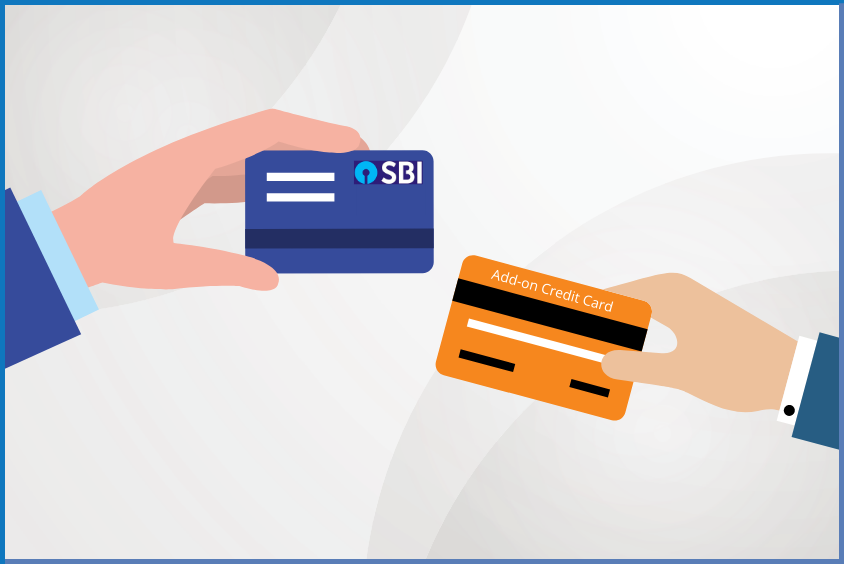The Add-on Credit Cards have removed the barriers of income proof, credit score, and steady income. Most of the credit card features are limited to the primary cardholder only, like in the airport lounge access, where only the primary cardholder is allowed to visit the lounge. But with the add-on card, the family member can also visit the lounge along with the primary cardholder. Therefore, the add-on card provides the same offers and benefits as the primary card. So, if you are holding any SBI credit card, you can avail of the Add-on credit card facility for your family member. Getting the SBI add-on credit card is a very simple and quick process, and moreover, the SBI additional cards are lifetime free as they do not have any annual fee. These can be issued to your spouse, parents, and your children if they are above 18 years of age.

Features of the SBI Add-on Cards
The Add-on credit cards work similar as the primary cards, however, they are some extra features that must know:
- The SBI add-on card is issued without any cost and are lifetime free.
- The additional cards would get the same reward rate as the primary card and the cardholder can redeem the same as per their choice.
- The primary cardholder has full access to the Add-on cards. Therefore, they can manage the card and also keep a track of transactions on the same.
- The credit limit for the Add-on cards is shared with the primary card. The primary cardholder can also change the limit for a cash advance, online purchases, and more anytime. The bank may also intervene for the limit on the add-on cards.
- All the bills and monthly statements for the Add-on card are sent to the primary cardholder as a consolidated statement. Therefore, the primary cardholder will be liable to make payments on behalf of the Add-on cardholders. Also, note that any late payment for the add-on card will impact the credit score of the primary cardholder only.
- The Add-on card can be used for International transactions, only if International Usage is enabled on the Primary Card
- The fuel surcharge waiver limit will be shared with the Primary card
Fees for SBI Add-on Credit Cards
The annual charge for the SBI add-on credit card is completely NIL, therefore they are lifetime free, but the fees and charges applicable for any SBI Add-on credit card are similar to the primary card. Therefore all the charges on the card like finance charges, cash advance fees, late payment fees, etc. would be the same as the primary card. For example, if you apply for the Add-on SBI Prime Credit Card then the charges for the card would be similar to the primary Prime card. For better understanding following is the table that summarizes some of the charges applicable on the regalia card, which would also be applicable for the Prime Add-on card:
| Charges | Amount |
| Finance Charges | 3.5% per month (42% annually) |
| Cash Advance Fee | 2.5% of the amount withdrawn or Rs. 500 (whichever is higher) |
| Rewards Redemption Fee | Rs. 99 Per redemption |
| Foreign Currency Markup | 3,5% of the transaction amount |
Eligibility Criteria for SBI Add-on Credit Cards
Following are the eligibility criteria you must keep in mind before applying for the Add-on card:
– The applicant for the Add-on card must be above 18 years of age.
– The applicant must be related to the primary cardholder.
– The Primary cardholder must maintain a good credit score.
– The applicant must have the consent of the Primary cardholder.
Documents Required for SBI Add-on Credit Cards:
To apply for the SBI Add-on credit card, the Bank may ask for certain documents that would be required to issue the card. following are some of the documents that are asked for
- Photo ID proof: PAN Card, Passport, Student ID Card, Voters ID, Ration Card, Company ID Card, or Passbook.
- Address proof: Passport, Driving License, Telephone/Electricity Bill, Bank account statement, Voter ID, etc.
How to Apply for SBI Add-on credit card
After ensuring that you are eligible for the SBI Add-on card and preparing the required documents, you can apply for the card. Following are the steps to apply for the SBI Add-on credit card:
Applying online:
– Login to your account at sbicard.com with your User ID and Password.
– Apply for Add-on Card on your SBI Card Account.
– Fill out the form and submit it.
Applying offline:
– Download the Add-on Card form from the bank’s website.
– Fill in the details and submit them at,
– SBI Cards and Payment Services Pvt. Ltd, P.O Box No-16, G.P.O New Delhi-110001
SBI Add-on Credit Card PIN generation
The PIN for the Add-on credit card is sent to the cardholder along with the Add-on card. If you want to change the PIN for your Add-on card, then the process is very simple. Following is the way by which you can change your SBI Add-on Credit card PIN:
Through website:
– Login to your SBI Card account
– Select the card for which pin needs to be changed
– Click on ‘Generate OTP’
– Enter the OTP
– Enter the New PIN twice, and click on ‘Submit’
Through mobile app:
– Click on ‘Service Requests’
– Click ‘Manage Pin’
– Select the card for which pin needs to be changed.
– Tap on ‘Generate OTP’.
– Enter the OTP.
– Enter the New PIN twice, and tap on ‘Submit’.
SBI Credit Cards that offer Add-on Credit card Facility
There are many credit cards offered by the SBI Card that come with the Add-on Credit card facility, following are some of such cards that offer great benefits and must be considered:
| Card | Fee Structure | Main Features |
| SBI Elite Credit Card |
|
|
| SBI Prime Credit Card |
|
|
| SBI SimplyCLICK Credit Card |
|
|
| Air India SBI Signature Credit Card |
|
|
Bottom Line
With the SBI Add-on card facility, the cardholders can get an additional card for their spouse, parents and children and provide them with financial liberty. The add-on card is very beneficial for those who want to enjoy the benefits of a credit card without any annual charge. If any of your family members holds an SBI credit card, then you should get an add-on card against it as it will offer you with same benefits and rewards.










